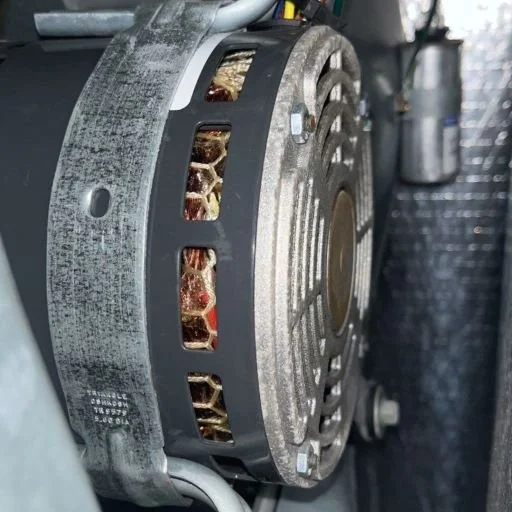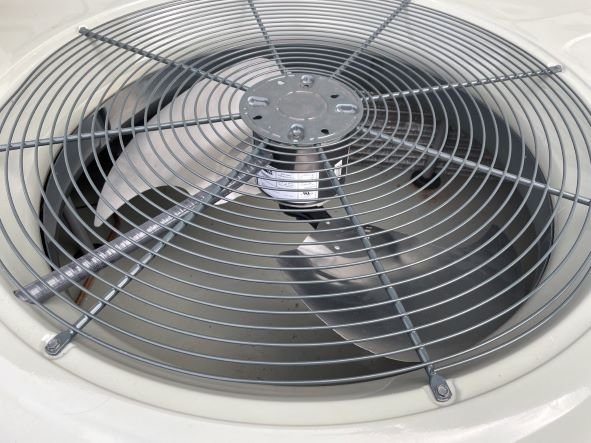Bad Condenser Fan Motor?
What should your next step be?
Maybe you noticed that your condenser fan is no longer turning, or an AC repair service company recommended replacing the fan motor. Either way, you need to know what a condenser fan is, what it does for your HVAC system, and what options you have. Continue reading this article we will give you all the information that you need to know when dealing with condenser fan motors.
Air Conditioning Fan Motors
There are two main types of HVAC motors: the outdoor unit (condenser) and the indoor air handler (evaporator). Condenser fans help dissipate heat from the high-side refrigerant inside the condenser coil. In an air handler, fans, also called a blower motor, are used to circulate air through the evaporator coil and throughout a conditioned space. To create efficient air movement, the fan assembly is typically housed in sheet metal or plastic so that it draws air from a specific area and moves it to a specific area.
Fans are carefully balanced and should run with little noise. A fan is usually connected to a motor shaft with setscrews. The fan motor may be attached to brackets and mounted with rubber grommets. Generally, motor leads from the power source to the condenser fan are connected to the common terminal and the running terminal of a compressor motor. This connection puts the fan motor in parallel with the compressor motor and allows it to be controlled by the thermostat. When the compressor runs, the condenser fan motor also runs.
Many fan motors have two or three-speed settings. The speed of fan motors is quite sensitive to the applied voltage. As the applied voltage drops, so will the fan speed. It should be noted that varying the applied voltage of induction motors is not a safe or accepted method for controlling fan speed. Speed control is better done using a variable frequency drive.
Fan motors can be set up to directly drive a fan using a coupling or use a belt and pulley assembly. A technician should regularly check the condition of a fan’s belt. Check for frays and cracks. Poorly aligned pulley and wheel can cause premature wearing of a fan’s belt. With regular maintenance, a belt-driven fan and its motor should provide years of good service.
What is a Condenser Fan Motor?
First off, what is a condenser? A condenser is going to be installed along the outside of your home. These are commonly referred to as the air conditioner or heat pump. Normally they are a large box shape. It will have a fan mounted to the inside of the top and it will be connected to your house by a piece of conduit and two copper lines.
You may not have a condensing unit; you may have what is referred to as a package unit. Where your entire air conditioning and heating system sits outside in one package, instead of having half outside and half inside. These will normally be much larger than a traditional condenser and have ductwork attached to it that penetrates your home. These units will still contain a condenser fan found mounted to the top of the unit, even if it may be in a slightly different fashion.
The condenser fan motor is the large fan motor attached to the top of the inside of the condenser. It has a single shaft protruding from it, and generally a two or three-sectioned fan blade connected to the shaft. This motor will turn on every time the condenser turns on and will blow air out the top of the unit. This motor’s job is to pull cold air through the hot coils of the condenser cooling the coils off and blowing the resulting heated air out of the top. If you have ever felt the air blowing out of the top of your condenser this is why it is so warm.
Without the condenser fan running, the air is unable to move across the coils to cool off the freon inside of your air conditioning system. This can cause your system to overheat, you will have very little to no cool air coming into your home, and if left unchecked it can result in catastrophic failure of your equipment. Your unit will have certain ways to protect itself against complete failure, but it is best to find and fix the problem as soon as possible to reduce the risk of further damage.
If your condenser fan motor has failed, it is generally easy to notice. You will be able to hear your compressor running, but the fan blades will not be turning. Sometimes there can be other problems with the fan though. For example, it could still be turning but making grinding noises or loud screeching, which may indicate that the bearings have worn out. Maybe it has become off-balanced and has vibrated your condenser to the point that the fan or fan motor mount is coming apart. Or maybe your fan has developed issues that are beginning to pose a threat to the health of your condensing unit. Whenever a fan motor's structure, mount, or fan fails it can result in catastrophic damage being caused to the inside of your condenser.
Types of motor failures
Three general areas of motor failures are as follows:
Problems with the motor starting components
Mechanical problems with the motor
Motor winding failures include:
Open windings
Shorted windings
Shunted windings
Grounded windings
Starting and safety components that can fail and give the appearance of a defective motor are as follows:
Running capacitor
Starting capacitor
Potential relay
External overload
Internal overload
Mechanical problems include the following:
Bearing failure
Drive problems
Safety Tip
BELT-DRIVE COMPONENTS CAN CAUSE SERIOUS INJURY IF YOU ARE CAUGHT IN A MOVING BELT, PULLY, or motor shaft rotation. ALWAYS LOCK OUT THE POWER TO THE UNIT BEFORE WORKING ON THE BELT DRIVE. THIS INCLUDES ANY BELT ADJUSTMENTS, PULLY ADJUSTMENTS, OR BELT CHANGES.
Should you replace it with an OEM or Rescue motor?
A condenser fan motor replacement and all air conditioner repair work should always be performed by an HVAC professional. Your HVAC technician will sometimes give you the option of installing an OEM motor or a rescue motor. An OEM motor is just that, an Original Equipment-manufactured motor. These motors are made for your specific application, they will only have one RPM and one horsepower option.
OEM motors are going to be the most common condenser fan motors installed by service technicians. OEM motors generally must be ordered from a local distributor. Depending on the age and brand, these motors may not be in stock and take several days to receive. These are the most popular options. OEM motors come with manufacturer warranties and are generally easier to replace. However depending on the brand, the price of these motors is typically higher than the rescue motor. Typically, the customer seems to be a little hesitant about departing from the manufacturer's recommended parts.
Rescue motors are manufactured with versatility in mind. These motors are made to be kept on a service truck in case almost any size of motor breaks down and needs to be replaced. They are designed to operate with a broad range of different horsepower, making them a very flexible option. One fan can be equipped for a 1/6th HP to a 1/3rd HP capacity. The Rescue brand motors have also stepped up their technological game with higher efficiency replacement models as well. Certain fan models are equipped with Bluetooth, which can be connected to the system if applicable to your system so that it can run more efficiently and effectively. These motors require some specialized knowledge to install and will sometimes have to be programmed for your specific application. One drawback could be that OEM motor shafts extend to a specific length based on enclosure design. Installation of a rescue motor may affect the operating characteristics of your unit. Rescue motors are a great option for a temporary repair, especially if the OEM motor is not available for a few days. The negative here is that you end up paying the labor costs twice.
How much does it cost to replace a condenser fan motor?
The big question for every customer is, "What is this going to cost?" The typical from every question AC company is, "It depends." There are as many prices as there are types of condenser fan motors. The cost of the motor is the biggest variable. For each type and brand, the price will vary. Most HVAC companies have a standard fee for replacing the motor, and labor costs. There will be a small amount of material charge, wire nuts, tape, etc. No special tools are needed. Some companies charge a diagnostic fee for troubleshooting the issue. Some other factors that might affect the price:
Location of the outside unit
Difficult access (i.e. crawlspace)
Enclosure design
Single-phase or three-phase
Final Thoughts
Now you know what condenser fan motors are, and where to find them. You know what to look for if you suspect that a condenser fan motor may be to blame for your air conditioner not working. You should be able to give your AC repair company a good idea of what the problem may be when you give them a call. A condenser fan motor might be an easy thing to self-diagnose, but it is not necessarily something that an average homeowner should attempt to replace. There are dangerous moving parts and voltage involved. It is always best to call a professional and have them diagnose and replace potentially dangerous items.



